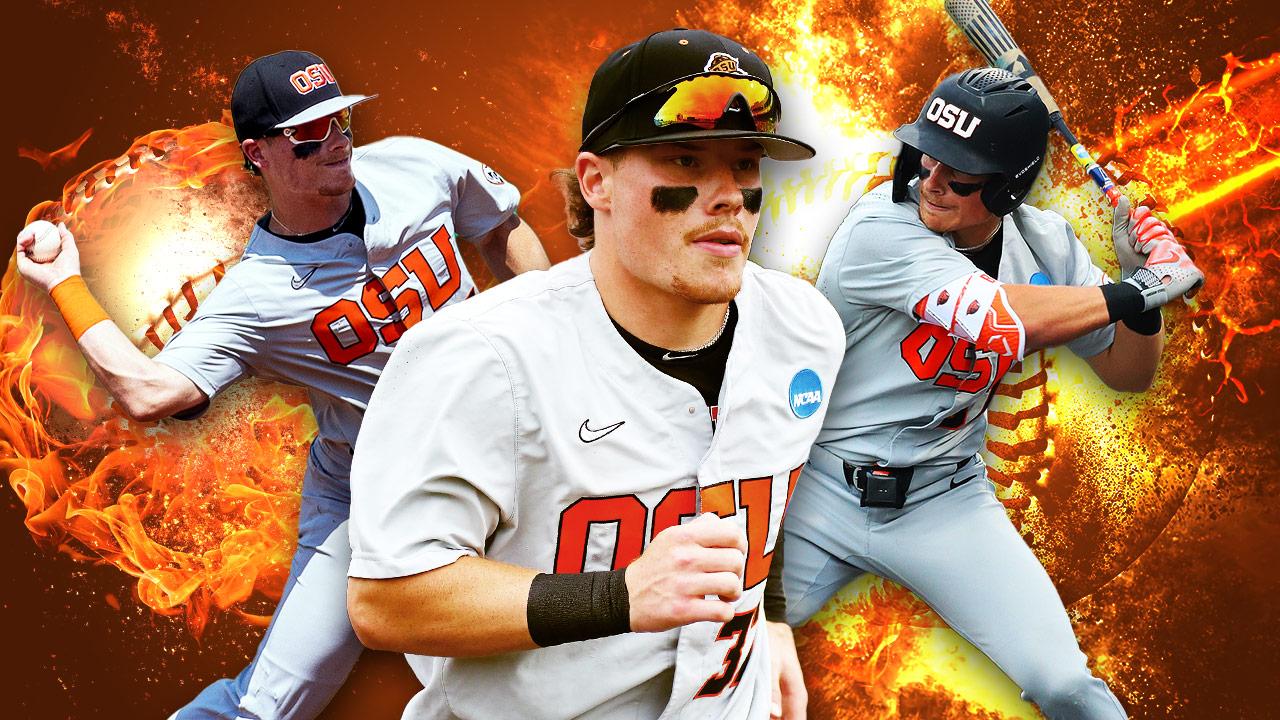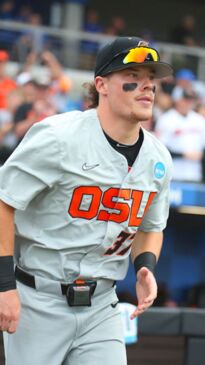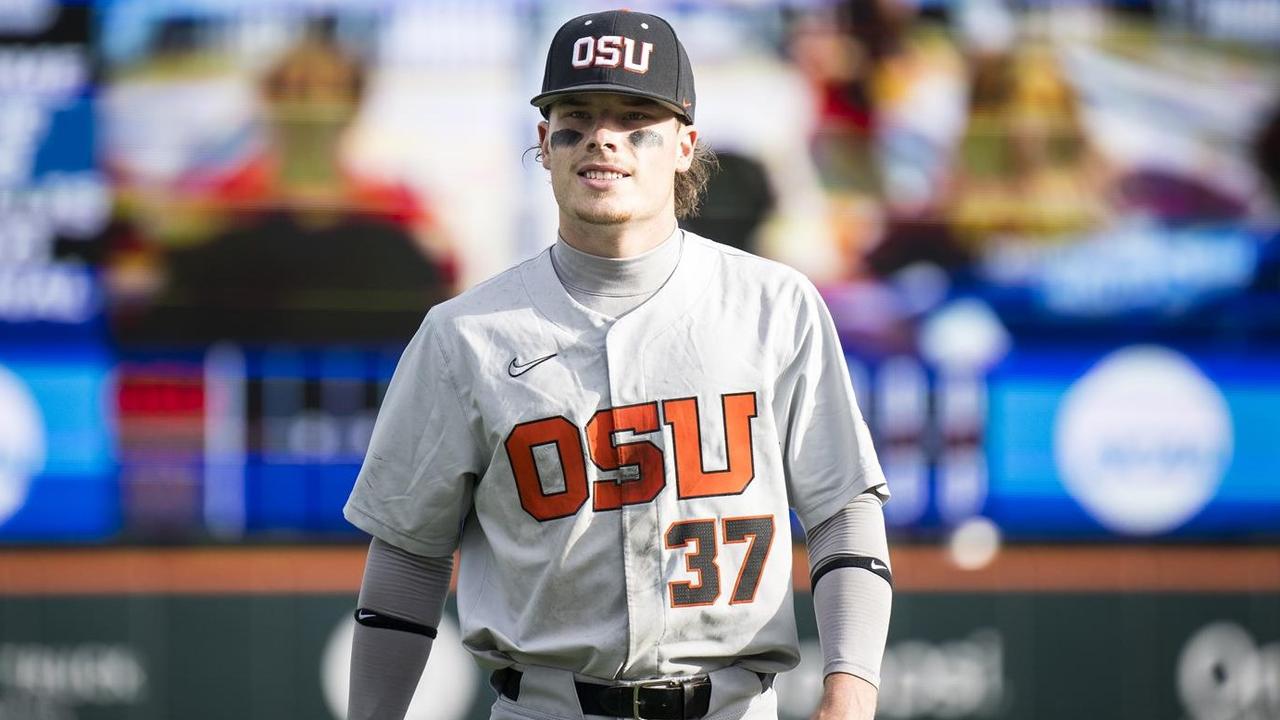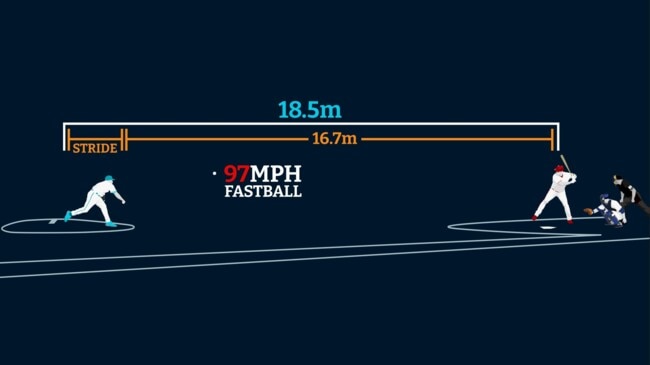He has always been humble, yet confident, but rising baseball star Travis Bazzana is set to transform Australian sport after becoming the No.1 pick at this year’s MLB Draft. JAMIE PANDARAM takes us inside his journey from northern Sydney to the cusp of the Major Leagues here.
Three years ago, a Major League club handed Travis Bazzana a deal most teenagers can only dream of: play baseball professionally in the US and get paid $130,000.
But Bazzana wasn’t like most teenagers. Then 17, he was insulted by the $US90,000 offer.
“He is a very humble kid, but he’s also very internally confident, and he felt he was worth more than 90 grand back then,” said Andrew Riddell, a former college pitcher turned player development manager with Baseball Australia.
“To only get that offer, and not get more, I think to him was like, ‘OK, I’m going to college and I’m going to prove you all wrong. I will show you this is what I’m worth’. And he’s been able to do that.”
The confident snubbing of that initial offer is set to pay extraordinary dividends, as Bazzana created history on Monday by becoming the first Australian to be drafted in the first round of the MLB draft.
Many including the MLB’s own website predicted he would be the No.1 overall pick, and that proved true on Monday, guaranteeing him a starting salary of $US10.5 million ($15.5 million).
It marks one of the most significant moments in Australian sports history.
“It’s pretty crazy,” Bazzana’s father Gary said.

“He is literally living in a different world, we’re meeting people we never would have met, and it’s been going on for him for some time, it’s just the Australian media that has worked it out in the last week or so.
“He wants to have a positive impact and help grow the game here.
“He has realised how powerful a platform he has, and how he can make a positive impact. I don’t think initially he thought he could have that big of an impact, but he’s really conscious of it.
“He is pretty mature in the way he thinks about things. In the three years he’s been away from Australia he’s certainly grown up in leap years.
“He wants to send the message that you can do things in baseball from Australia that maybe we thought weren’t possible once upon a time.”
The Bazzana family gathered in a hotel room in Oregon, with a television camera beaming their faces live to millions around the world, while in northern Sydney Travis’ old club Ku-ring-gai Stealers hosted a watch party with former teammates, coaches and friends.

The Cleveland Guardians took Bazzana with the first pick of the draft, and instantly baseball in Australia has been transformed.
“We won a silver medal at the Athens Olympics in 2004, that started a wave and a generation of kids that grew up wanting to play baseball, I was a part of that,” Riddell said.
“We’ve been waiting for the next wave. This sets up that next page, to get to the next generation of kids.”
Put in context, Australia has never had a player signed before the fifth round of an MLB draft.
Pitcher Josh Spence was picked in the third round by the Los Angeles Angels in the 2009 draft but did not sign, instead pursuing another year in college. The following year he was drafted in the ninth round by the San Diego Padres.
Spence’s brother Liam, and pitcher Phil Brassington, were picked in the fifth round.
Bazzana has surpassed all expectation, and broken significant records after rejecting the MLB offer three years ago to instead attend Oregon State, a college that has produced superstars like Adley Rutschman and Jacoby Ellsbury – who in 2013 signed a $US153 million deal with the New York Yankees.
This year, 21-year-old Bazzana set an Oregon State single-season record with 84 runs scored, 28 home runs and a .911 slugging percentage.
His ball-striking ability is uniquely powerful for a player who stands 183cm.
Jason Pospishil coached Bazzana for four years in the Baseball NSW high performance program.
“For a guy of his size and stature, the bat speed that he is able to create is more advanced than other players of the same size,” Pospishil said.
“In baseball terms he’s not a real big guy, he is [six foot], when I was scouting we would only be looking at guys six-foot plus, whereas Travis is more of a smaller guy with the traditional speed profile, well he’s got the speed profile and the power profile to be able to hit home runs.
“That separates him as a second baseman, because it’s not something generally thought of because second basemen have more of a speed profile, a line drive, good contact, speed type of player. But he has got that speed plus the power, and that power comes from his ability to generate top end bat speed.
“I know he spent time at the Driveline facility (an Arizona-based specialised baseball practice arena driven by data) and he was able to develop his skills and bat speed there.
“And he learned to pull the ball in the air with better ball flight. When he was a younger player he used to hit the ball with top spin, what that means is the ball has got top spin and dives towards the ground, whereas now he’s got the ability to pull the ball with back spin which allows it to carry, and that’s allowed him to increase his home run totals.
“That was an area he saw he could improve on when he was younger, we had conversations about it, he’s probably had a lot of other conversations about it with hitting coaches as well, but it’s something I identified with him and he’s worked hard on that.
“But the thing is, you get a lot of guys who identify areas in their game they need to improve, but they never quite do it. How quickly he has been able to identify an area, go and get the necessary help, and he’s adjusted and put it into play when it matters in game situations, that’s what makes him special for me.”
The time spent in college allowed Bazzana to hone his craft like no other.
“Had he taken that offer three years ago, he would have started at the bottom level as a 17-year-old,” Riddell said.
“He would have tried to work himself up through six levels, and you can get released at any moment. You can wake up tomorrow and they can say, ‘See you later mate, your contract’s done, we’re putting you on a plane home’.
“That is the cutthroat life of a minor league baseball player.
“He was always an undersized kid, late maturing with his body with strength and power, so I don’t think anybody could have anticipated his development growth the last three years.
“He’s developed himself as that player. There are about 14 clubs that have scouts who live out here in Australia, and none of them could predict what he’s been able to do, because they would have offered him more money three years ago.
“It’s a testament to his hard work.
“His best friend, Jimmy Nati, turned down $US250,000 [by an MLB club] as a high school kid to go to Stanford, he’s followed the same pathway, and we’re hoping he gets drafted next year.
“So there’s more kids now that may get offers, $10,000, $20,000, $50,000, that may say ‘No’ and go to school, whereas 10 years ago they were signing pro and starting their careers and then being released by 20 or 21 back in Australia with nothing, they then have to start university as a 21-year-old.”

Baseball Australia is encouraging more of their young stars to follow the college pathway, given the unpredictable nature of turning pro from high school.
Recently retired Australian pitcher Josh Gessner last week shared his tumultuous journey of signing with the Philadelphia Eagles in 2019, but failing to play a single MLB game, enduring throwing yips in 2021 and toiling through the six levels of the minor leagues.
Riddell said Bazzana’s choice to attend college was crucial for his game-time.
“If Trav had done that, he’d have foregone the opportunity to go to Oregon State and having the college career that he’s had,” Riddell said.
“As a 17-year-old undersized Aussie kid, you’re going up against 21-year-olds from America and South America with developed bodies, who have played the game for longer, it’s a much tougher way to work through the minor league system.
“Travis went to school for three years, he got 600 at bats, he got a lot more game time. When they go to spring training next year he will probably go straight to Double A, so instead of going from Rookie Ball, then to A Ball, then to High A and then Double A if he’d signed as a 17-year-old, he’ll probably now jump straight to Double A.”

Bazzana is among more than 600 players in the draft.
“He’s a little bit embarrassed that he gets presented as a Major League star or Major League player and at this point in his life, he’s really conscious that he’s had a fantastic college career but he hasn’t played a professional game,” father Gary said.
“Even if he is in the first round of the draft, that doesn’t ever guarantee you’re going to play a Major League Baseball game because there’s layers you’ve got to work through and stay healthy and play well to even step foot on a Major League field.
“He’s really mindful that it is only one step in his journey, and draft day is going to be amazing but it’s only one step. He wanted to have an amazing college career, and then an amazing professional career and that hasn’t even started yet.
“He’s happy that people are excited about where he’s at, but it really is just the start.
“It is a little bit scary, he grew up like any other normal kid in Sydney, his life is not exactly normal at the moment.
“There is a lot of attention on him at the moment, and a lot of demands on his time. The college life is really busy to start with, he was going to classes, studying a full-time psychology degree, they practice, train, and now there’s an additional layer to negotiate with contracts and sponsorships.
“You worry a little bit, he is in a different world now. It may be trickier for him in future to just go and enjoy a meal without people wanting to come up and talk to him or ask for an autograph – he is really patient with that and handles it well.”
An undeniable feature of Bazzana’s rise to stardom – regardless of who you speak to – is his unwavering work ethic.
“Part of his success is that he did work very hard on his own game, and works things out himself,” Gary said.
“It is a game you can practice solo to an extent. We were fortunate to have access to a batting cage at the Ku-ring-gai Stealers club where he could practice at night, practice in his own time with a ball-throwing machine.
“We had an agreement from when he was about 12 years old that if he wanted to practice, we’d go hit. But I never asked him to do it, because I wanted it to be up to him.
“We’d generally get there after dinner for a hit, to do whatever it took to get better.
“Later on when he was a little older, he’d have his dinner, do his homework, go to the gym and then we’d go hit, occasionally that was 10.30pm or 11pm. We had access and there was a lit cage, so he did hit a lot of balls in those days.”
It is difficult to appreciate how talented Bazzana is for the non-baseball audience.
Pospishil makes this analogy: “I played cricket as a kid, imagine batting and you get a full toss from Shoaib Akhtar or Brett Lee at 160kmh, because that’s 100mph, coming at waist height, and try to hit that ball square, with a cricket stump.
“And baseball’s harder because in cricket, it might swing a bit, but in baseball you get could a ball that moves in, moves out, go down or up, there’s far more variation in a baseball pitch than a cricket delivery.
“For the generic person out there, hitting a baseball at collegiate or professional level is probably the hardest skill to do in all of sport.
“You’re trying to hit a round ball with a round bat, and you’ve got to hit it square to produce good ball flight. And you’re looking at velocities now anywhere up to 100 miles per hour over a distance of 60 feet, the ball can be inside half a plate, outside half a plate, up, down, they can change speeds, they can make the ball spin or curve in different directions.
“The level of hand-eye coordination that you have to have, just to put the barrel of the bat where the ball is.
“They’ve figured out that with a 90mph fastball, you’ve got 0.4 of a second to make your decision whether you’re going to swing, and get the barrel to the ball.
“That’s at 90mph, and now you’ve got guys that are routinely at 100mph, so that goes down to 0.25 to 0.3 of a second, so in my mind it is the hardest skill in all of sports.
“You’ve got to get the barrel from where it is in the stance to the contact point with the ball, based on your eyes identifying what type of pitch it is, what location, what speed, all these things have to happen in 0.25 to 0.3 of a second.
“So in that context, it’s ridiculous.
“There are five or six factors you’ve got to consider.
“You are making a decision whether you swing or don’t swing. Every day in our jobs we have to make a decision, some people get a month to make a decision.
“If you’re baseball player, you’ve got 0.25 to 0.3 of a second every single time you swing the bat to make a decision.”

More often than not, Bazzana makes the correct decision.
American commentators were left stunned by the “cricketer”, a misconception Gary explained was due to a media form his son filled out in his first college season.
“He did take up cricket when he was 10 or 11, with his schoolmates, there was a point when his club baseball could be played on a Friday night and he could join a cricket team on a Saturday and he played with friends of his from Warrawee Public School in the St Ives district cricket comp,” Gary said.
“He played both sports for a little while, but he was always more passionate about baseball, and was always playing representative baseball on a Sunday.
“He was a handy cricketer, it’s often discussed whether he could have been a cricketer or not.
“In the baseball commentary at Oregon State they’ve said a few times he played cricket, that’s happened because when he first filled out his media form for Oregon State it had a page for your high school statistics; who was your coach, what was your batting average?
“They were talking about baseball, but his high school at Turramurra High didn’t have a permanent baseball team, he didn’t play baseball as a school sport, most of the baseball in Australia is played at the community level, for clubs on the weekend.
“In America a lot of the sport at that level is played through the school or college system. So when we filled out that page, we filled out his cricket stats, and was the captain of the school team.
“That piece of paper stayed in his profile forever, and every time an opposing commentator picked it up they talked about how he played cricket.”
Gary, his wife Jenny and Bazzana’s older brothers Mitchell and Hayden shared the draft experience with Travis, and a special function has been organised for them.
It caps a remarkable journey that can be traced back to when Gary began playing baseball as a primary school student in Lismore.

“When I was growing up, we played cricket in summer and baseball in winter, which is against the trend for most of the world, but that was where it came about,” Gary said.
“I had a primary school teacher, at Nimbin Central Primary, who was a member of the local cricket club and local baseball club, and he encouraged us all to play.
“That’s where my love for it started.
“Travis had a couple of older brothers playing in Sydney when he was a toddler, he was dragged along and fell in love with it from a young age.
“He started playing from about four years old, teeball, so he started at a very young age.
“He had success and was recognised as a rep player early in his career, he had some good mentors and was in high performance systems at an early age. That fuelled him.
“I didn’t have pay TV to watch Major League Baseball, but from the age of 11, he was immersed in it because he could Google all that stuff. He was constantly watching highlights of games, or lessons in how to hit a baseball harder, how to make a baseball, all sorts of things.
“Later on it became really important because he could find out what he wanted to build himself into, he could look at how fast he needed to run to play at college, how hard he had to throw the baseball, then find the training tools online that he would constantly be tinkering with to be the best he could be.”

Travis Bazzana timeline. Graphic supplied by baseball.com.au
While Bazzana has stunned analysts in the US with his rapid improvement, Riddell always believed.
“Because it’s Travis, I’m not surprised,” Riddell said.
“Knowing him since he was 14 years old, mentally, the drive, the work ethic, and the confidence he had as a kid, I think he was always going to be successful.
“I’m not surprised he’s had the college career he’s had, but it is amazing that he’s being talked about as the No.1 draft pick.”
It is a milestone moment for a sport that rarely gets mainstream cut-through in this country.
Australia was ranked sixth in the world before Covid restrictions hit, and they were unable to play matches to accrue points and have slipped to 11th.
But at the World Baseball Classic last year, Australia narrowly missed out on a semi-finals spot by losing 4-3 to Cuba, which Riddell says is a more realistic indication of where the team is at.
“We finished fifth, that shows everyone in the world where we actually are,” Riddell said.
“Now we’re back playing games and travelling again, we’ll be able to build our world ranking back to where it was pre-Covid.”
The Australian system is viewed as one of the best in the world. There have been 71 players who have moved on to the Major Leagues since playing in the Australia Baseball League.
They include MVP Ronald Acuna Jr, Japanese star Shota Imanaga, and all-stars Andrew Kittredge and Liam Hendriks – a pitcher who has earned close to $100 million in his career but would barely be recognised by the average Australian sports fan.
Bazzana is following a similar trajectory for career earnings, but is set to change the landscape by becoming Australia’s highest profile baseballer.
“He always wanted to be great and play at the highest level he could, but the interest in his life at the moment is an eye-opener,” Gary said.
“He seems to be handling himself really well. I get a lot of messages from people that he’s spent time with their children, or turned up to events to support something, that people appreciate, and that makes you feel proud as a parent that it’s still part of his make-up.
“He does answer a lot of messages from kids in Australia asking for advice on going to college or improving their own game. He was once one of those kids that would ask those questions.
“He knows how proud we are of him, in so many ways, only some of those have to do with his ability to hit a baseball. And he’s got two awesome older brothers and we’re fiercely proud of the people they are as well.”

‘Crazy’ buzzer beater for the ages rocks NBA
The Denver Nuggets have pulled off a miracle with one the craziest moments the NBA Playoffs have seen in recent years.
Rugby league player drafted in NFL drama
A Western Sydney product’s dreams have come true with some late drama unfolding at the NFL Draft on Sunday morning.